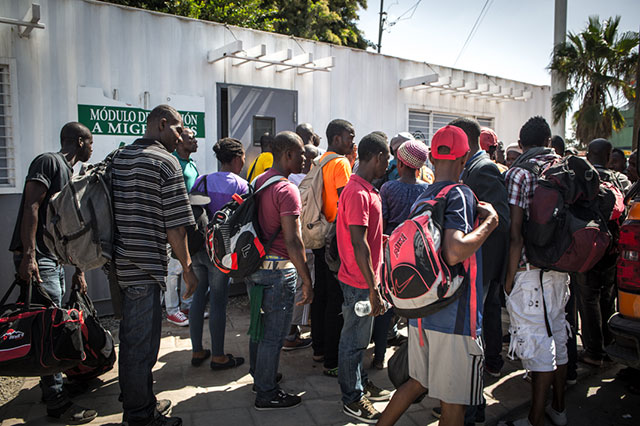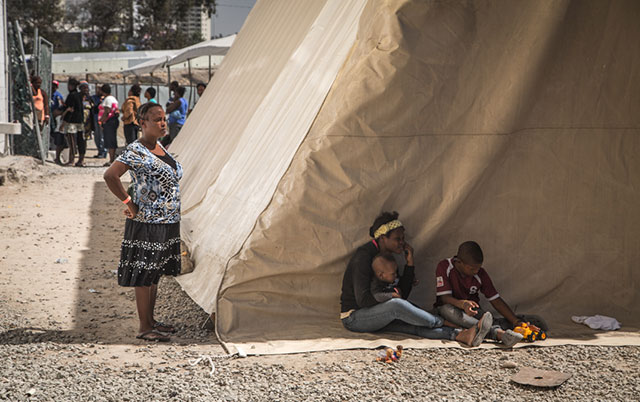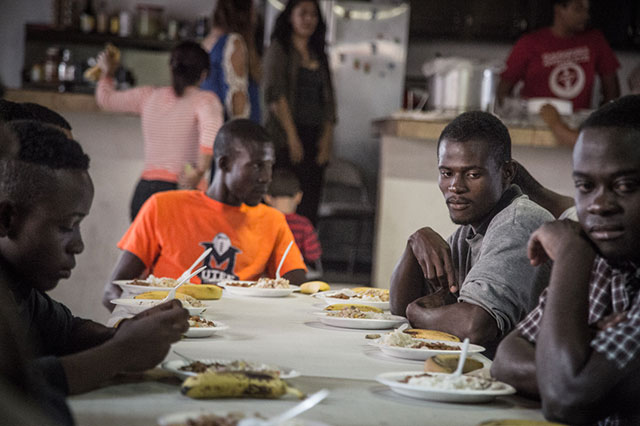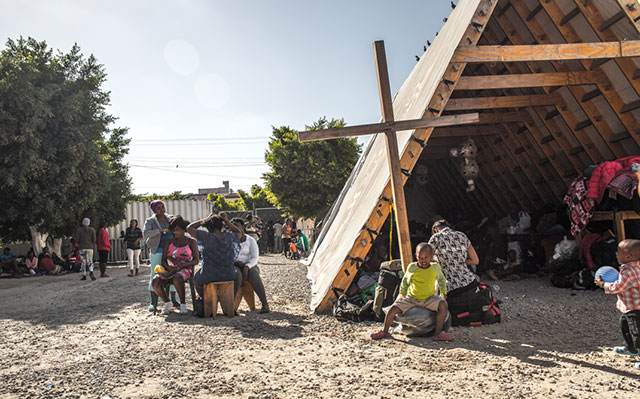
Tijuana, Mexico — “People want a bit of land, to be able to study and to have hope for a better life,” said Bernard Deshommes, 32, from Port-au-Prince, Haiti. He left after the 2010 earthquake that destroyed his home, and relocated to Chile.
“When people have public safety and sanitation, they don’t want to leave their country,” he told Truthout. He is now staying in a shelter at a Pentecostal church in Tijuana, Mexico, waiting to cross to the United States. Facing economic difficulties in Chile, Bernard is one of thousands of Haitians in South America who have decided to go to the US, which has offered temporary residency to Haitians since 2011.
Bernard is among the 2,000 Haitians who have found themselves stuck in Tijuana, as a recent policy change has complicated their plans to reach the US: On September 22, 2016, the US repealed the Temporary Protected Status (TPS) that it had granted to Haitian immigrants starting in 2012 due to the humanitarian situation following the 2010 earthquake.
“I hold the government of the United States responsible for this crisis,” says Margarita Andonaegui of the Salesiano Padre Chava shelter in downtown Tijuana. She has been helping Haitians since hundreds starting arriving in the border city in May.
As Haiti begins the recovery from Hurricane Matthew, victims of the 2010 earthquake have congregated in Tijuana, even though they face an uncertain future upon entering the US.
From the Brazilian Dream to the US Border
 A family waits inside the Padre Chava shelter in downtown Tijuana. (Photo: Heriberto Paredes)
A family waits inside the Padre Chava shelter in downtown Tijuana. (Photo: Heriberto Paredes)
The majority of Haitians arriving in Tijuana have traveled north by land from Brazil. Following the 2010 earthquake, Brazil offered visas to Haitians to work in construction jobs in the burgeoning economy. Others entered as undocumented migrants via Ecuador and Peru. The Brazilian Federal Police recorded 65,000 Haitians entering Brazil between 2011 and November 2015. Others went to Chile and Argentina.
However, Haitians have faced discrimination, low wages and uncertain legal status in South America. As the Brazilian economy unraveled in the past year, and a coup pushed Labor Party President Dilma Rousseff from power, conditions have worsened for Brazilians and migrants alike. The economic opportunities that drew them to Brazil and relieved the extreme need following the earthquake eventually dried up.
Thousands have decided to try their luck in the United States.
To reach the US border without a visa, the Haitians first have to cross nine countries, relying on coyotes for the majority of the journey, leaving Brazil to Peru and through Ecuador and Colombia to Central America. The overland crossing from Colombia to Panama is one of the most dangerous and demanding legs of the trip.
Nicaragua has placed restrictions on undocumented passage through the country, and many Haitians report robberies, assaults and extortion. Wilenda Nicolas, 24, was staying in the Padre Chava shelter in Tijuana. She found a 3-year-old Haitian girl abandoned in Nicaragua and has been caring for her since.
“I searched for her family and couldn’t find them, so I decided to take her along with me,” she told Truthout. “I now have made contact and learned her mother was detained in Nicaragua. She will try and find us in Miami if she makes it.”
Coyotes charge between $5,000 and $7,000 for the long journey.
Arriving on the Guatemala-Mexico border, Haitians turn themselves in to INAMI, the Mexican immigration authorities. Mexico does not have diplomatic agreements with Haiti to deport the migrants and instead issues “exit visas” to Haitians. The exit visas allow migrants to travel through Mexican territory to the US border for 20 or 30 days without being detained or deported but does not permit them to stay in the country long-term. From Tapachula, Chiapas, near the border with Guatemala, migrants head straight to Tijuana, Baja California.
“It takes about a week to get from Tapachula to Tijuana, or some people stop through Mexico City,” says Bernard Deshommes.
According to Customs and Border Patrol (CBP) data, by early October, 4,844 Haitians had turned themselves in this fiscal year, compared with just 795 at the same point last year.
Tijuana Struggles to House Thousands
 Men finish lunch at the Ambassadors of Jesus church on the western side of Tijuana. (Photo: Heriberto Paredes)
Men finish lunch at the Ambassadors of Jesus church on the western side of Tijuana. (Photo: Heriberto Paredes)
Andonaegui of the Padre Chava shelter, has been on the frontlines receiving hundreds of Haitian migrants every week. She explained to Truthout that the crisis began in May.
“The United States asked INAMI and the organizations that help migrants in Tijuana to assist over the long Memorial Day weekend. There were already hundreds of Haitians in Tijuana trying to cross.”
The shelter has bunk beds where 88 people can sleep comfortably, and she reserves space for deported Mexicans, the population the organization typically works with.
“That weekend the situation blew up,” Andonaegui said. “And that weekend has extended in an unprecedented way, up until now.”
CBP asked the Tijuana government and INAMI to manage the influx of Haitians turning themselves in at the border. The city government and INAMI then turned to four Tijuana-based organizations to coordinate to bring 100 Haitians to the border every day. CBP received these groups and released them on humanitarian parole in the US. While anyone has the right to arrive at the US border and seek asylum, CBP only accepts those brought through the 100-per-day system.
Organizations, such as Padre Chava, not only feed and house the migrants, but assist CBP in receiving them on the border. Haitians showing up directly on the border are turned away and told to go through one of the organizations or INAMI.
“Temporary Protected Status” for Haitians Repealed
 A game of dominoes starts after lunch at the Ambassadors of Jesus church. (Photo: Heriberto Paredes)
A game of dominoes starts after lunch at the Ambassadors of Jesus church. (Photo: Heriberto Paredes)
Since 2011, Haitians have had “Temporary Protected Status” in terms of immigration to the US. In January of that year, the US halted its deportations to Haiti, and Haitians could receive temporary US visas due to the severe humanitarian challenges in Haiti after the 2010 earthquake.
In April 2011 the US Department of Homeland Security (DHS) began some deportations, targeting Haitians with “orders of removal and [those] convicted of a serious crime, or who posed a national security threat.”
However, on September 22, 2016, the DHS announced no new Haitian arrivals would receive Temporary Protected Status. Homeland Security Secretary Jeh Johnson said in a press release that the conditions in Haiti had improved sufficiently to resume standard deportation practices. Individuals currently covered by Temporary Protected Status retain their status, which has been extended to July 22, 2017. The DHS acknowledged that the surge on the border was a driver of the policy change.
The American Immigration Lawyers Association released a statement questioning the repeal of Temporary Protected Status. Executive Director Benjamin Johnson said, the Department of Homeland Security “needs to explain how it will ensure these vulnerable people will not be sent back to what are still extremely unstable and even violent conditions in Haiti.”
Hurricane Matthew Makes Landfall
 The Padre Chava Salesiano shelter has housed Haitians since May. (Photo: Heriberto Paredes)
The Padre Chava Salesiano shelter has housed Haitians since May. (Photo: Heriberto Paredes)
On October 4, 2016, less than two weeks after the Temporary Protected Status announcement, Hurricane Matthew made landfall in southern Haiti with windfalls of over 135 miles per hour. The Category 4 storm was the strongest Caribbean hurricane in a decade.
Haiti was the hardest-hit country in the region, and as of October 10, the death toll had passed 1,000. The UN Office for the Coordination of Humanitarian Affairs estimates 1.4 million people are in need of humanitarian assistance in the country of 10 million. Haiti’s presidential elections, which were scheduled for October 9, have been postponed once again, with no new election date announced yet.
Civil society groups spoke out against the decision to begin deporting Haitians, pointing out that 60,000 Haitians are still living in earthquake displacement camps. Another concern is the conditions deported Haitians face. In the past, they have been sent to prisons that lack basic hygiene and health care and that are prone to outbreaks of diseases such as cholera.
On October 11, 2016, Secretary Johnson announced that deportations to Haiti would be temporarily suspended due to Hurricane Matthew, but that “after that condition has been addressed, we intend to resume the policy change that I brought about several weeks ago.”
For the time being, Haitians will not be deported, but Temporary Protected Status has not been extended to those who arrived in recent weeks.
Tijuana Residents Step Up for Haitian Migrants
 Families wait at the Padre Chava shelter for their dates to cross to the US. (Photo: Heriberto Paredes)
Families wait at the Padre Chava shelter for their dates to cross to the US. (Photo: Heriberto Paredes)
Migrants shut out of the United States have wound up in Tijuana for over a century, starting with Chinese migrants deported from the US at the turn of the century, one of the country’s first exclusionary immigration policies. Today, deported Mexicans and Central Americans unable to cross to the US swell Tijuana’s population.
However, the presence of Haitians is particularly visible in a city with relatively few African-descended residents. Many Tijuana residents have found ways to contribute to humanitarian efforts. Yuridia Sánchez was moved to help by a news report on the Haitians stranded in her hometown.
“I am a really sensitive person. I was so impacted watching the news, and that day I posted on Facebook to get my friends to help out,” she told Truthout in an interview at her home, while five other Tijuana residents prepared a pasta salad. Now she is coordinating a team to prepare over 300 meals a day for the Haitian migrants.
“Civil society has done more to help than the government,” said Sánchez.
The important work being done by volunteers of Tijuana is apparent at the improvised shelter currently being run by the Ambassadors of Jesus Pentecostal church in a marginal neighborhood tucked into a canyon in western Tijuana.
The church’s pastor decided over a month ago to take in Haitians whom the city shelters had run out of room to house. Roughly 150 are staying in the church and Sánchez’s team arrives each day to serve generous lunches. The city government donated some nonperishable food supplies, but otherwise the families were sheltered and fed out of church-member and volunteer donations.
Unclear Future for Haitians at the Border
The migrants who have turned themselves in after September 22 are in a legal limbo. There are some women traveling with children who were released at the border to meet family members who had already made it to the US. However, the majority of those crossing at San Isidro are sent to immigration detention. Truthout tracked Haitians who recently crossed from Tijuana and were sent to the Eloy (Arizona), Otay Mesa (California) and West Tennessee immigration detention facilities. Secretary Johnson said in a statement on October 12 that, “Removal flights have been suspended temporarily. Working with the government of Haiti, DHS intends to resume those flights as soon as possible.”
The Haitians arriving now in Tijuana will have to wait until late November or December to cross. Thousands more Haitians are reported to be heading north through Central America and Mexico. With the population swelling every day, immigration advocates are nervous about responding to the overwhelming need. Local authorities have called for federal assistance.
“It got out of hand for the local, state and federal government,” said Maria Galleta of the Tijuana-based organization Madres y Familias Deportadas en Acción (Deported Mothers and Families in Action).
The organization typically works with people deported from the US, including mothers and US veterans, but it also helps orient Haitians who arrive at its office, just steps from the El Chaparral border crossing.
“The government is doing absolutely nothing,” chimed in Galleta’s co-worker Ixchel Solano.
Andonaegui of Padre Chava said the Haitians are caught up in electoral politics and their plight will not be resolved before the general elections. “The United States created this crisis, and Mexico has not been able to deal with it,” she said to Truthout.
Meanwhile, Bernard Deshommes waits for his date to cross to the US, where he will seek asylum. He passes his time at the Pentecostal shelter, where people play dominoes and some men have started to work at local businesses.
“When I get to the US I am going to see if I can study and find someplace to work, to continue following my dream,” Deshommes said.
For him and the thousands of Haitians arriving on the border, the future, upended in the 2010 earthquake, remains uncertain.
We’re not backing down in the face of Trump’s threats.
As Donald Trump is inaugurated a second time, independent media organizations are faced with urgent mandates: Tell the truth more loudly than ever before. Do that work even as our standard modes of distribution (such as social media platforms) are being manipulated and curtailed by forces of fascist repression and ruthless capitalism. Do that work even as journalism and journalists face targeted attacks, including from the government itself. And do that work in community, never forgetting that we’re not shouting into a faceless void – we’re reaching out to real people amid a life-threatening political climate.
Our task is formidable, and it requires us to ground ourselves in our principles, remind ourselves of our utility, dig in and commit.
As a dizzying number of corporate news organizations – either through need or greed – rush to implement new ways to further monetize their content, and others acquiesce to Trump’s wishes, now is a time for movement media-makers to double down on community-first models.
At Truthout, we are reaffirming our commitments on this front: We won’t run ads or have a paywall because we believe that everyone should have access to information, and that access should exist without barriers and free of distractions from craven corporate interests. We recognize the implications for democracy when information-seekers click a link only to find the article trapped behind a paywall or buried on a page with dozens of invasive ads. The laws of capitalism dictate an unending increase in monetization, and much of the media simply follows those laws. Truthout and many of our peers are dedicating ourselves to following other paths – a commitment which feels vital in a moment when corporations are evermore overtly embedded in government.
Over 80 percent of Truthout‘s funding comes from small individual donations from our community of readers, and the remaining 20 percent comes from a handful of social justice-oriented foundations. Over a third of our total budget is supported by recurring monthly donors, many of whom give because they want to help us keep Truthout barrier-free for everyone.
You can help by giving today. Whether you can make a small monthly donation or a larger gift, Truthout only works with your support.